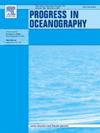Wind-driven upwelling in the Adriatic Sea: Coastal vs. open-sea processes
IF 3.6
3区 地球科学
Q1 OCEANOGRAPHY
引用次数: 0
Abstract
The paper concentrates on the east Adriatic and a ten-day (20–29 May 2017) interval when a research cruise has been carried out, when the bottom probes have been operating close to the coast, and for which the satellite data have been available. Meteorological modeling has shown that two pulses of northern winds occurred at the time. The shipborne CTD and ADCP data collected on 28 May 2017 revealed a dense-water dome, with the surface cyclonic circulation developed around it, at a distance of 15–20 km from the coast. The temperature bottom probes and SST satellite sensors pointed to a decrease of temperature on two occasions, around 21 and 25–27 May 2017, close to the coast. The coincidence of the wind pulses with these processes in the sea indicated that they could be interpreted in terms of the wind-driven open-sea and coastal upwelling. In order to verify the interpretation, a simple analytical model has been developed and a combination of meteorological and oceanographic numerical modeling, with the wind field decomposed into the curl and curl-free components using the Helmholtz-Hodge approach, has been utilized. The theory and numerical simulations showed that the open-sea upwelling was related to the wind-curl effect while the coastal upwelling was controlled by interaction of the boundary and wind-curl effects. The phenomena were influenced by a positive feedback mechanism, which is more pronounced in shallow basins than in deep basins. This suggests that comparative studies of upwelling phenomena in different basins may be useful.
亚得里亚海的风驱动上升流:沿海与公海过程
这篇论文集中在亚得里亚海东部和一个为期10天(2017年5月20日至29日)的时间间隔上,当时进行了一次研究巡航,海底探测器在海岸附近工作,并且已经获得了卫星数据。气象模型显示,当时出现了两次北风脉冲。2017年5月28日收集的船载CTD和ADCP数据显示,在距离海岸15-20公里的地方,有一个密集的水穹,周围形成了地面气旋环流。温度底部探测器和海温卫星传感器在2017年5月21日和25日至27日前后两次指向靠近海岸的温度下降。风脉冲与这些海洋过程的重合表明,它们可以用风驱动的公海和沿海上升流来解释。为了验证这一解释,我们建立了一个简单的解析模型,并结合气象和海洋数值模拟,利用Helmholtz-Hodge方法将风场分解为旋度和无旋度分量。理论和数值模拟结果表明,公海上升流与风旋度效应有关,沿海上升流受边界和风旋度效应的共同作用控制。这种现象受正反馈机制的影响,在浅盆中比在深盆中更为明显。这表明对不同盆地的上升流现象进行比较研究可能是有用的。
本文章由计算机程序翻译,如有差异,请以英文原文为准。
求助全文
约1分钟内获得全文
求助全文
来源期刊

Progress in Oceanography
地学-海洋学
CiteScore
7.20
自引率
4.90%
发文量
138
审稿时长
3 months
期刊介绍:
Progress in Oceanography publishes the longer, more comprehensive papers that most oceanographers feel are necessary, on occasion, to do justice to their work. Contributions are generally either a review of an aspect of oceanography or a treatise on an expanding oceanographic subject. The articles cover the entire spectrum of disciplines within the science of oceanography. Occasionally volumes are devoted to collections of papers and conference proceedings of exceptional interest. Essential reading for all oceanographers.
 求助内容:
求助内容: 应助结果提醒方式:
应助结果提醒方式:


